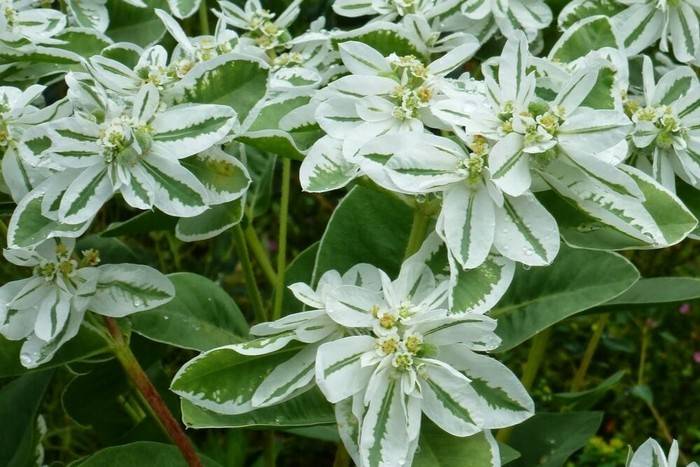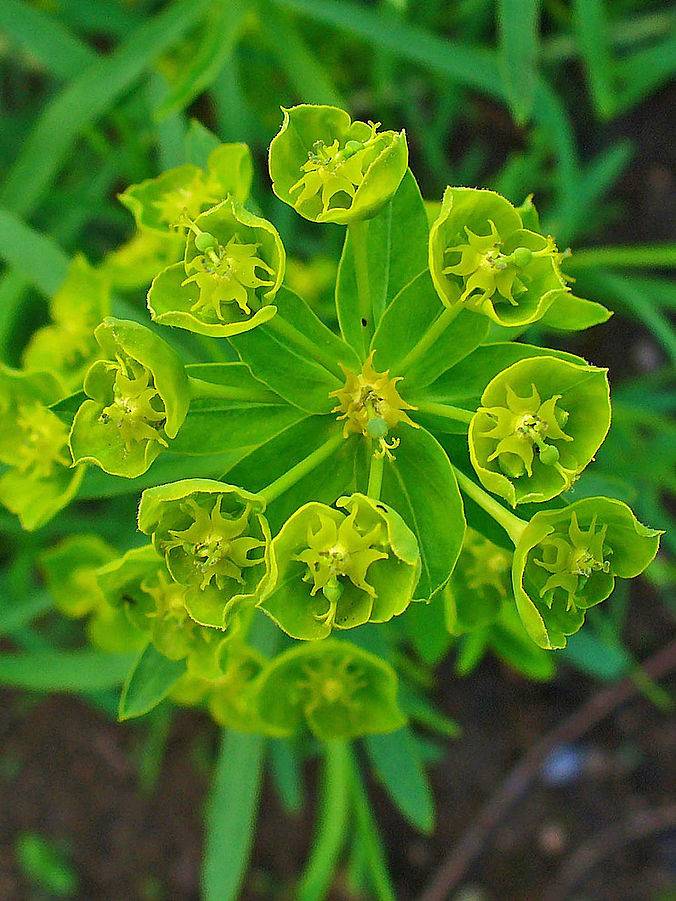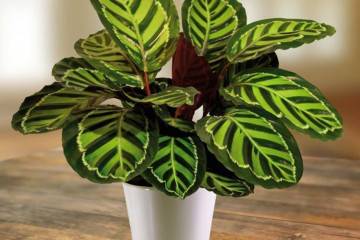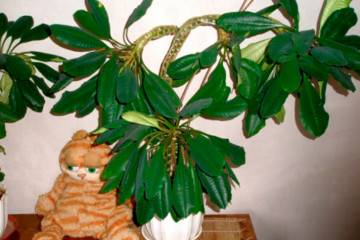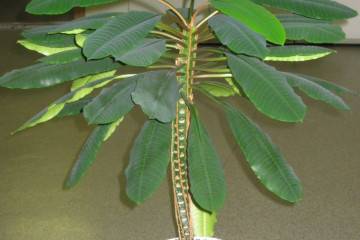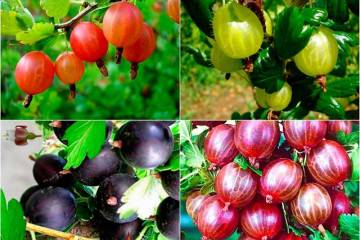Garden spurge (Euphorbia) - description of multi-flowered, marsh species
Content:
Among the wide variety of flower cultures, it can be difficult to decide. I would like to plant everything at once. One of the unusual options is garden spurge. This interesting perennial plant will be a real decoration for any garden.
What does a garden spurge look like?
Euphorbia belongs to the Euphorbia family. Depending on the type, the spurge can be either annual or perennial. The appearance of the plant also depends on the variety. It can be both a herbaceous plant and a tree or shrub.
Classification of popular types of milkweed
Description of the types of garden milkweed:
- multiflorous is a herbaceous perennial. Euphorbia multicolor is distinguished by a spherical shape of a bush. The height of the stems reaches 70 cm. Large-flowered perennial forms lush inflorescences, collected from small yellow flowers;
- comb is a houseplant. Euphorbia is a poisonous one. The leaves are large, oval in shape with white veins. Blooms from the first year of planting;
- field is a weed. Field euphorbia is not used for landscaping areas;
- marsh is characterized by thick erect shoots. Euphorbia marsh is distinguished by a lush round bush;
- white-veined is a house plant. Leaves are oval in shape with thick white veins. Caring for the white-lobed milkweed is simple. The plant can grow both in the sun and in partial shade;
- trihedral. This variety is often confused with a cactus. Stems are fleshy, long, spines are located along the entire length. The leaves are small;
- almond-shaped. Plant height up to 70 cm. Stems are erect. The lower part of the stem is lignified. The leaves are small, oblong-oval. Inflorescences are yellow;
- cypress. Height is not more than 50 cm. Stems are erect, thin needle-like leaves. Inflorescences are spherical yellow;
- bordered has erect stems, up to 70 cm high. Leaves are silvery-green, with a white border along the edges;
- myrtle is distinguished by thick, fleshy leaves of a silvery color. Euphorbia myrtle is used to decorate alpine slides;
- capitate is a short (5-10 cm) shrub that is used as a ground cover. The flowers are yellow or orange. Differs in winter hardiness;
- stone-loving. Lanceolate leaves, yellow flowers. From the name you can understand that he prefers to grow on rocky soil;
- Wallenstein's spurge belongs to street weeds.
The cultivars that are most popular with horticulturists
Popular flower varieties:
- Kilimanjaro. Height up to 70 cm, silvery foliage with a white border. Inflorescences are small, petals are white;
- Rock crystal is similar in appearance to the Kilimanjaro variety;
- Mountain snow. The foliage is silvery-green, the inflorescences are small, inconspicuous;
- Early snow. Height up to 70 cm. Leaves are oblong with a white border. Flowers of a white shade are small and inconspicuous in appearance;
- Climber. The stems are thick, the leaves are small. Inflorescences are spherical yellow;
- Obergonia De Negri. The stem is spherical and covered with thorns.Forms one large white flower;
- Albomarginata forms a lush leafy rosette;
- Dexter. The flowers are small, salmon-colored. The foliage is rich in light green color.
How spurge breeds
Planting and caring for garden milkweed do not differ from those for other varieties.
How to propagate spurge:
- seeds;
- cuttings;
- dividing the bush.
Another way is by cuttings. With the help of them it is better to propagate in spring and summer.
How to propagate by cuttings:
- The cut cutting is placed in warm water for a few minutes so that all the juice comes out.
- Then the place of the cut is abundantly sprinkled with charcoal.
- After the cuttings are laid out on a towel and left for 1-2 days, so that they dry out a little.
- They put the cutting in the ground, watered and covered with a bag.
- Rooted in the same soil in which it is planned to plant euphorbia.
The most time consuming method of propagation is by seed. They are sown in the ground, watered, lightly sprinkled with soil. Cover the container with cling film. When the sprouts appear, you can remove the film. The pick is carried out after the formation of two full-fledged leaves.
Features of care in the garden
As mentioned earlier, the cultivation and care of multiflower milkweed do not differ from that of other varieties. Taking care of a flower is easy.
Spurge in the garden can be planted in the sun, partial shade or shade. Does not like waterlogged soil. In a rainy summer, the flower should be regularly examined for the appearance of diseases.
Planting and caring for perennial garden milkweed mainly consists in regular weeding, loosening the soil and applying fertilizers. Weeds need to be weeded out as soon as they appear. It is advisable to loosen the soil once a week before watering. This will saturate the soil with oxygen.
Top dressing is applied twice during the growing season. Both mineral and organic substances can be used as fertilizers. The first time feeding is applied at the beginning of the growing season, the second time - at the end of July. You can use Kemir-Lux or Aquarin preparations. From organic matter, wood ash, humus and rotted manure are suitable. Closer to autumn, you can again add rotted manure.
You can protect the rhizome from frost by mulching the soil. Rotted manure, sawdust, peat or special agrofibre are used as mulch.
Mulch benefits:
- the root system is protected from frost;
- weeds stop growing;
- the soil does not dry out;
- the soil does not need to be loosened.
Shoots are pruned as needed. A well-sharpened secateurs are required to trim the stems. There should be no creases in the places of the cuts.
How to prune spurge:
- before pruning, the pruning shears are wiped with alcohol so as not to infect the wounds;
- you can cut off weak branches, dried stems and faded peduncles. You can also thin out bushes if they are overgrown;
- pruning is necessary if the flower is affected by insects or diseases. In this case, all affected parts of the bushes are cut off and destroyed.
After trimming, the cuts can be sprinkled with wood ash, but this is not necessary.
When and how it blooms
Not all varieties of milkweed bloom.Inflorescences are mainly formed in varieties intended for outdoor cultivation. The flowering period also depends on the variety. Some species can bloom in late spring, others in summer.
In most hybrids, flowers are collected in globular inflorescences. Yellow petals. There are species with pink five-petal flowers.
Flowering care does not need to be changed. The only thing is that at this time you can apply top dressing to the soil so that the flowering is more magnificent. It is also worth increasing the amount of watering.
Possible growing problems
When growing milkweed, you can face several problems:
- pests:
- illness;
- improper care.
Insects can cause significant damage to the flower. Pest control can be done with chemicals. It is allowed to spray the bush with Actellik or Fitoverm preparations. For mealybugs and whiteflies, insecticides are used.
Diseases develop due to improper care. Skor or ridomil gold helps against fungal diseases.
Use in landscape design
Euphorbia is often used in landscape design. The plant looks harmoniously with other flower crops. Some varieties are suitable for decorating rockeries and alpine slides. In addition to all the advantages, euphorbia is also a very unpretentious plant, not demanding on growing conditions.
Euphorbia has long been very popular among flower growers due to its unusual appearance and ease of growing. From a large number of varieties, everyone can choose a variety to their liking.

